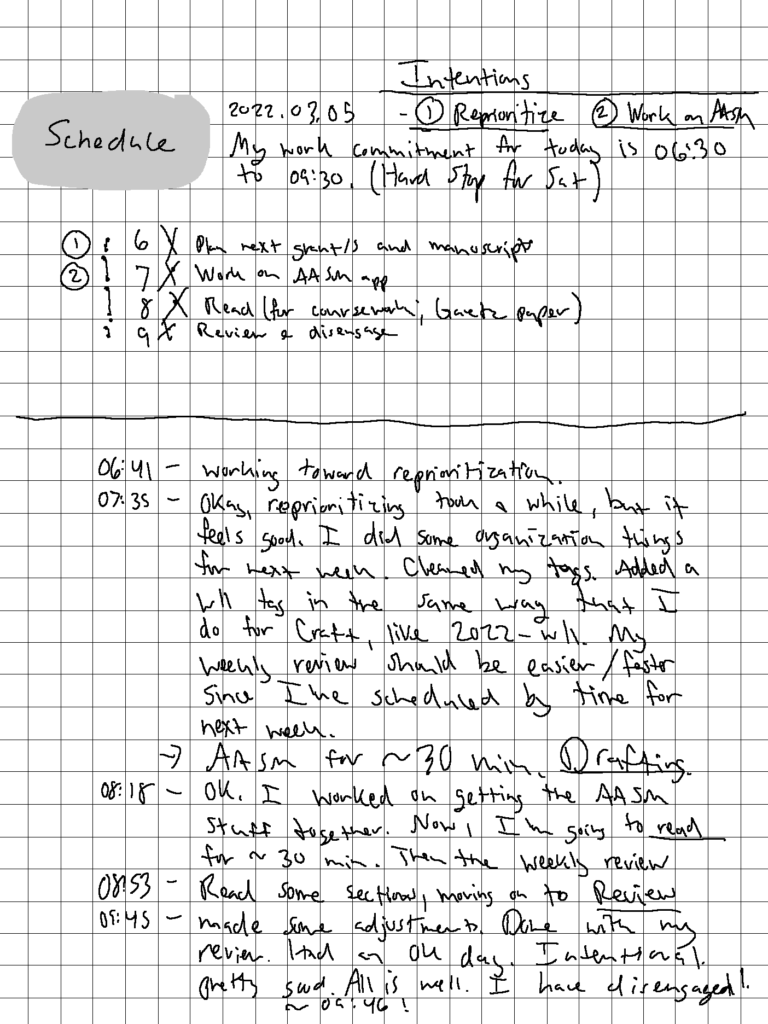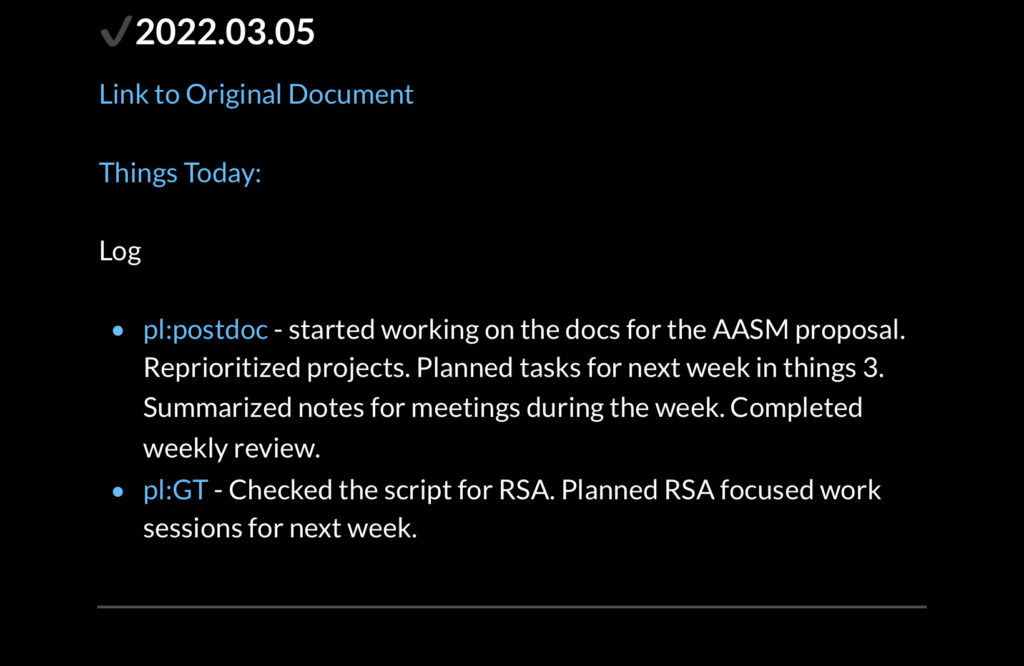
Interstitial journaling helps me to organize my daily work schedule as an academic researcher. | postdoc diaries #2
Have you ever gotten to the end of your work day and could barely remember what you actually worked on? You were busy and working all day, but you just couldn’t remember if you got anything important done. Some days are scattered across email responses, meetings, conference calls, and admin tasks, making it hard to recall what, if anything, was actually accomplished by the end of the day. How can we take meaningful steps towards our goals in the midst of the noise? How can we be sure that we make some progress, at least a little, every day that we show up to work? One method has brought me more focus and awareness to my days is interstitial journaling.
Interstitial journaling helps bring mindfulness to time management
Interstitial journaling is a mindfulness-based productivity technique developed by Tony Stubblebine. He designed the interstitial journaling method to be more thoughtful about the way that he worked and interacted with distractions during the day.
Interstitial journaling is a simple logging practice. Whenever you start working on a task, note the time and briefly summarize what you’re working on. When you stop working, either because you finished, took a break, or got distracted, note the time and what happened.
The act of interstitial journaling encourages focus throughout the day. It aligns with research-based components of mindfulness, including Dr. Shauna Shapiro’s, Intention, Attention, Attitude (IAA) model of mindfulness.1
First, interstitial journaling involves intention setting. Noting goals gives us a written record of what we want to accomplish and can aid in holding ourselves accountable for meeting our goals. When intentions are clear, it gives us our “why.” What is the purpose of our current actions in this moment? Mindfulness is about being aware of the present and not focusing on other things that have happened in the past or that may happen in the future. Interstitial journaling brings mindfulness into task management.
Second, interstitial journaling requires attention. This is the “what” of the IAA model. It is not enough to set an intention. We should also make an effort to maintain our attention on the given task. For example, if I set an intention to work on writing a draft of a research manuscript for 30 minutes, I should focus on that intention for that amount of time. Of course, my mind might wander. I may get distracted from time to time. If I find myself off reading other blogs instead of working on my manuscript, I should make a note of it in my interstitial journal and use the break to refocus.
Third, interstitial journaling facilitates attitude change. A component IAA model of mindfulness is attitude, or “how” we approach our current situation. My attitude about my distractions during the day could be negative and self-defeating, or it could be more compassionate and curious. If I berate myself for spending time reading other blogs instead of writing, that puts me in an even worse place. Instead, it’s a better use of my time and energy to meaningfully reflect on what’s driving my distractions. Why am I having difficulty focusing for 30 minutes? Did I get enough sleep? Am I frustrated about something regarding my manuscript? Interstitial journaling can help facilitate this kind of curiosity about the way that we go about our work days. It can also help us to be more reflective during our work, as it provides a log of what we accomplished in a given day and helps to illuminate areas of our work that we’ve done well and where we may need improvement.
Disengaging from the day with the interstitial journaling
In addition to interstitial journaling, I’ve added a disengagement routine to close my work days. At the end of each work day, I review my handwritten interstitial journal (image below, left) to write a brief, digital summary (image below, right) of my accomplishments for that day in any areas that I actively worked on. I also make a note of whether I met or missed my intention. If I met my intention, I mark the day with an “✔️”. If I missed it, I mark the day with an “✖️”.
Then, I set a focus area for the next day and prioritize time for that area. During scheduling, I make sure not to schedule my focus sessions during times that aren’t available for individual work (e.g., avoiding time that is allotted for meetings, seminars, courses).
Before I close my work day, I write a short mantra to myself that, admittedly, is a little silly: “All is well. I have disengaged.”2 Lastly, I note the time. These two actions serve as a reminder to myself that I am done with my work for the day. There is no more sitting at my desk, no more writing emails, nor checking my work schedule. That note represents the end of my work for the day and is a reminder that I can pick up tomorrow in good standing with myself.


The bottom line: interstitial journaling brings mindfulness into the work day
Interstitial journaling has been a key component to the way that I navigate my work days, and consequently, my life as a whole. Journaling during the day gives can give us time to routinely pause, think about, and reflect on what we’re doing, what’s happening next, and how we feel. It exposes distractions and uncovers barriers to our work. Although sometimes uncomfortable, this reflective process allows for the honesty with ourselves that initiates meaningful change. It encourages an iterative process for us to determine if our actions are in alignment with our goals. Through my experience with interstitial journaling, I have found a sense of calm, focus, and flow. I now bring intention into my work days and carry my intention throughout each individual task. I have learned to guide my attention to the tasks that I have set for myself. And, my attitude about my work has changed such that I use my interstitial reflections to guide positively-focused and self-compassionate reviews of my efforts. While my work routine is still far from perfect and constantly evolving, interstitial journaling is a daily practice for my work that is here to stay.
What are some tactics that you use to stay focused during your work day? To see more on techniques and tools for academic work, see my list on strategies for academic work productivity here. For regular posts on focused thought, sleep tips, and the interrelation between the two, consider subscribing to my reading list here.
––––––––––––––––––––––––––––––––
Notes:
1 Find the research article on the IAA model here and a video from Dr. Shapiro about it here
2 I developed this practice based on Cal Newport’s shut down ritual.
Enjoyed this post and want to say thanks?